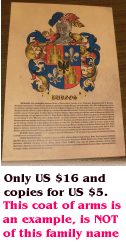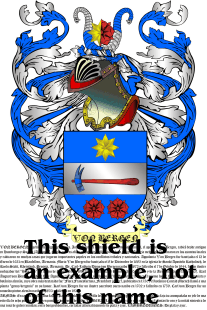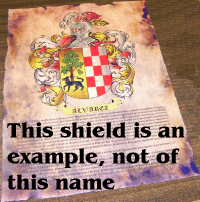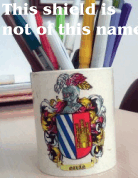We put at your disposal the bibliographical and heraldic sources, which are a beginning for the study of this family name.
SEVEN things you should know about the family name Poluekhta:
1) The origin of the family name Poluekhta.
2) The meaning of the family name Poluekhta.
3) The coat of arms and crest.
4) The bibliography
5) The nobility of the family name Poluekhta.
6) The prominent persons of this family.
7) The history of the family name Poluekhta.
8) Do you know what heraldic drawings mean?.
* Russia or the Russian Empire.
Bibliography that collects the history and the coat of arms for the family Poluekhta:
* Russian heraldry and nobility, by Donald R. Mandich and Joseph A. Placek.
Are you proud to belong to your family?
Do you want to know and have something important related to your family?. Click here
This name is the SYMBOL OF A FAMILY. If you have been invited to a wedding, event, meeting or anniversary,
make a GREAT GIFT FOR WEDDINGS, ANNIVERSARIES and events..
We put at your disposal the heraldic, the coat of arms and crest for this family name in various formats: The images that appear here are examples and none of them belong to the coat of arms for the name Poluekhta:

Parchment with the coat of arms, origin and history for the family name Poluekhta. Very cheap.

Coat of arms for Poluekhta and the history and origin for the family name Poluekhta in JPG or Vectorial files as Corel-Draw, AI, WMF, etc.
The history and heraldry of the family name Poluekhta appears in the Obschii Gerbobnik Dvorianskikh Rodov Vserossiiskoi (Russian Heraldry and Nobility), a magnificent book of heraldry and history of Russian noble family names, such as name Poluekhta, translated to English. This work was published by the Russian government in series from the year 1797 to 1840 and contains 2,198 surnames with its history and heraldic shield, among which is the family name Poluekhta. Heraldry appeared in Russia later than in Western Europe; It is generally accepted that it was copied from the west since the late seventeenth century. In the year 1722 the Emperor Peter I the Great established an Official Heraldry leaded by a Master of Heraldry under the jurisdiction of the Russian Senate. The first Vice-Master of Russian heraldry was an Italian. Under the Emperor Paul (1796-1801), since 1797 and for many decades, the Russian government accepted and published all the heraldic coats of arms nad family crests accepted and recognized. Not all the families collaborated in the registry, so there are more weapons in Russian heraldry than those collected in this work. Yes the family of the last name collaborated Poluekhta.
One of the most distinctive qualities of heraldry is the use of a limited palette of colours and patterns, usually referred to as tinctures. These are divided into three categories, known as metals, colours, and furs.
Next we are going to see the meanings of three tinctures:
1) ARGENT (Silver): Purity, Integrity, Obedience, Firmness, Surveillance, Eloquence and Expiration.
2) PURPLE: Justice, Wit, Truth, Greatness, Wisdom and Love; those who wear this color are obliged to defend the Prince defending ecclesiastical people.
3) SABLE: Black color that symbolizes Prudence, Sadness, Rigor, Honesty and Obedience.
Next lets look at the characteristics of some figures that we can find in heraldry and crests:
* ANGIO: The Chief of Angio, belonging to Italian heraldry, represents a political alliance with the Welf party (derived from Welf, Duke of Bavaria) who were loyal to the Pope.
* borduraNOusar: La Bordura simboliza Protección, Favor y Recompensa; asimismo la cota que vestían los caballeros y que al salir de la pelea, ostentándola manchada de sangre enemiga, eran premiados con el añadido de la bordura de escudo, como insignia de Valor.
* SHELL: The Shell symbolizes the Knight who marches to the borders of his states to widen them by fighting; it is also a symbol of Pilgrim.
* GYRON: The Gyron represents Favor.
* GOAT: The Goat symbolizes one who wins through politics rather than war.
* LAMB: The Lamb symbolizes the Kings and Leaders who have to sacrifice themselves to the good and care of their subjects; also denotes in the whiteness of fleeces, Qualified Nobility.
* WOLVES: The Wolves are a symbol of a Constant Heart that suffers the calamities of war and siege with generous spirit; but when the time comes to fight in the open field, he fiercely fights, without giving his enemy a barracks.
* YOKE: The Yoke symbolizes Unity.
* The family name Poluekhta appears in the list of last names of Heraldry & Crests so its complete history, crest and coat of arms or heraldic shields can be known on his website: http://www.heraldrycrests.com/
Heraldry for family name Poluekhta as well as its history is at your disposal here: Heraldry, history, origin, crest and coat of arms of the family name Poluekhta
Related Words: Poluekhta family crest | Origin of the name Poluekhta | Genealogy of the family Poluekhta | Heraldry of the name Poluekhta | Coat of arms of Poluekhta | Genealogy of the Poluekhta | Origin of the Poluekhta | Meaning of the name Poluekhta.

All the information about the surnames that are collected in this web site are based on verified bibliography.
Origin of family name, history and coat of arms/crests

